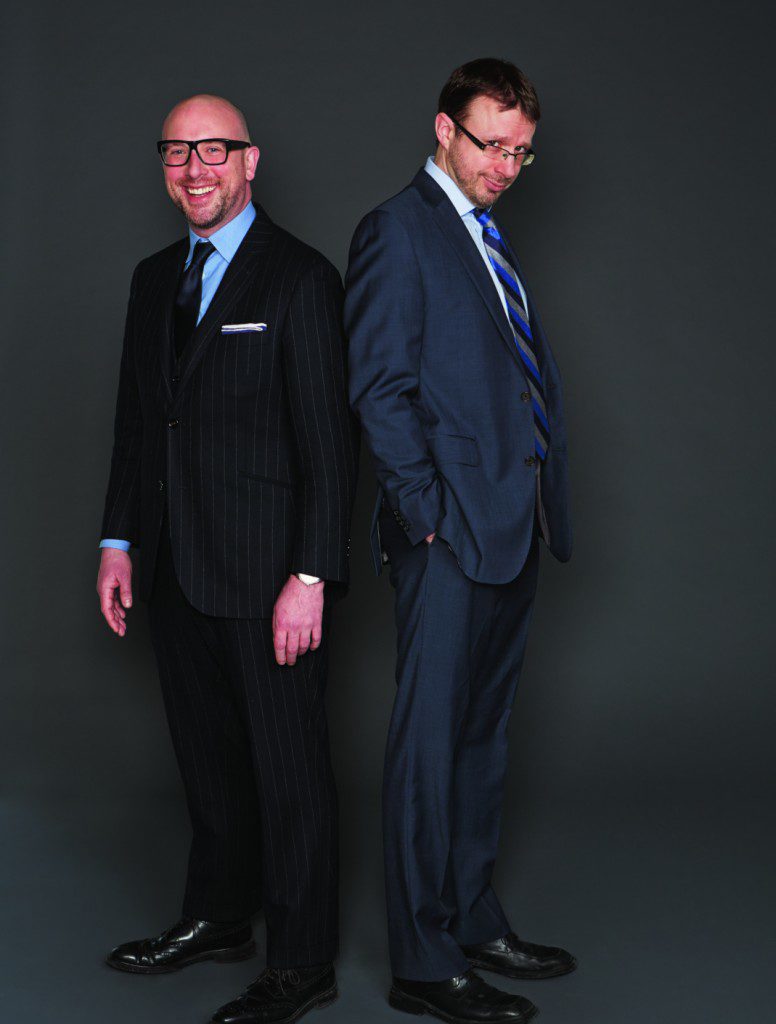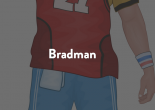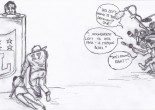Prize Fighters
Sports sections are on the ropes, but columnists with distinctive voices are still throwing punches
Dressed in a navy blue suit, Cathal Kelly sits on the edge of his seat hunched over his MacBook Air. Other writers in Toronto’s Rogers Centre press box sit back in their chairs, some chatting, others racing to finish their first stories of the day. Many are dressed in T-shirts and shorts to stay cool in the heat. It’s 1:07 p.m. and R.A. Dickey has just thrown the first pitch for the Toronto Blue Jays, but Kelly keeps his head down as a grin forms at the corners of his mouth. After years of covering baseball he relies on the crack of the bat to get his attention—even the screaming fans can’t break his focus when he is writing. Now he’s the only one whose eyes aren’t on the diamond. The sports columnist for The Globe and Mail writes quickly without stopping, mumbling quietly to himself. The only reason he stays in the press box is to avoid missing anything, but his column is unlikely to change unless “someone throws a grenade on the field.” He finishes his 800-word column just after the seventh-inning stretch. “I am not a nuts-and-bolts guy,” he says. “I want people to read it and have a laugh, think that five minutes was worth it.”
A couple of weeks later, Bruce Arthur is in Toronto’s Air Canada Centre, eating ham and scalloped potatoes in the media room before he heads up to the narrow press box in the rafters. The Toronto Star sports columnist slides in his earbuds to drown out the noise of the hockey pre-game show and writes his lede before checking Twitter, which he says helps him think. Beside him, Star beat reporter Kevin McGran has already started to write his story. After Toronto Maple Leafs sniper Phil Kessel scores in overtime, all the other reporters run to the locker room, but Arthur heads for the eerily quiet media room.
Later, McGran rushes in. “I wish I had more time,” he says. Arthur’s column is almost finished and he hurries to the locker room so he doesn’t miss the players. He talks to a few, then joins the rest of the reporters listening to then-head coach Randy Carlyle. Arthur stands off to the side intently focusing on his notebook. But instead of writing notes, he’s doodling a cartoon face with beady eyes—the same face he often draws to help him process information.
As two of Canada’s best sports columnists, Kelly and Arthur rarely have to worry about writing game recap stories. Their ability to blend culture and sport in their writing is a far more valuable offering. In 2014, crosstown papers scooped up both Arthur and Kelly. First, the Globe snatched Kelly from the Star, and then the Star raided the National Post for Arthur.
Sports sections are struggling to bring in new readers and keep existing ones in the face of increasing competition. But they still have their ringers: columnists with distinctive voices who cut through the clutter and keep readers coming back.
***
On Saturday mornings, eight-year-old Kelly wouldn’t get out of bed until he’d read a Hardy Boys book. Later, while studying political science at the University of Toronto, he worked in a bookstore, read prolifically and wrote “one really, really terrible” sports article for The Varsity. He then studied journalism at Ryerson University, eventually landing a job at the Star as a copy editor. Later, he became a beat reporter covering the Jays. He wrote with an “I dare you not to print this, I dare you to change it” attitude. “I never could adapt to being a beat writer,” says Kelly. “I was piss-poor at it.” Even as a beat reporter, he was writing columns and his editors would pull out his outrageous flights of fancy and goofy digressions. Looking back, Kelly says they saved him from himself and he now understands how right they were. He expected his editors to say his stories were idiotic, that they needed to find something else for him to do. And they did find something else—four years after he took over the Jays beat, the Star made him a columnist.
In March 2014, Globe sports editor Shawna Richer emailed him, asking if he’d like to meet up. They were friends and the request was a little more formal than usual, but Kelly didn’t think too much of it. When they met, she asked if he wanted to come work for her. Kelly was interested, but the relationships he’d formed over 14 years at the Star were hard to ignore. “My head was spinning,” he says. “I was going to all my rabbis in the business, guys I trust and saying, ‘How do I do this?’” One of them, Norris McDonald, current editor of the Star’s Wheels section, let Kelly babble on and on, then held his hands up. “Dick Beddoes, Allen Abel, Christie Blatchford, Stephen Brunt,” he said in his pebbly voice. “Those are four people who have done this job before you.”
Kelly’s departure wasn’t the only hit to the Star’s Sports section. Columnist Damien Cox announced that he was leaving for Sportsnet, though he would continue to write a weekly column. The paper moved quickly to fill the gap.
Monday, April 14, 2014 was one of the busiest days Arthur can remember. Before scheduled TV and radio appearances, he attended a press conference for newly appointed Leafs president Brendan Shanahan, who was the main subject in his next column. That evening, his kids threw him a surprise birthday party because he was scheduled to be on the road for the big day. Then, around 10 p.m., he met with Star editor Michael Cooke, managing editor Jane Davenport and former sports editor Jon Filson about making the move.
He thought about his decision carefully: he wanted to be good at his job and take care of his family. Although he didn’t like the idea of change, the offer was enticing. He took it. “I left a great job to go to a great job.” Going from the Post to the Star was “abrupt,” says Arthur. “It happened really, really fast.” He left the Montreal Canadiens playoff series and started covering the Toronto Raptors post-season effort, all within two days.
Exceptional sports writers have always been one of the strengths of newspapers. At the Globe, that tradition includes not just the writers McDonald mentioned, but also Scott Young, Trent Frayne and Roy MacGregor. The Star had Jim Proudfoot, Randy Starkman and, for decades, Milt Dunnell. Even the Post, the relative rookie among the big papers, fielded Abel, and Blatchford, who covered the Olympics before Arthur.
All of these sports writers earned the loyalty of readers with engaging profiles, colourful investigations and well-crafted stories. Like Young, some wanted to be novelists, some wanted to be political journalists and some knew from the beginning that they were destined to write about sports. All shared the ability to go deeper than what happened in a game.
That’s what may just save the sports section from extinction. The game story, also known as a “gamer,” is more difficult to write as deadlines get tighter while journalists get less access to players and must create more content on a variety of platforms. Besides, when fans can watch any game on television, receive game updates on their phones and find almost limitless analysis on the web, a game story in the next day’s paper is largely irrelevant. One of the worst things in sports journalism is the play-by-play, says Arthur. “It’s like Morse code. It’s completely value-free.”
***
Doug Smith was in a bar one night in September 2004 when his phone rang. The voice on the other end claimed to be Toronto Raptor Vince Carter and said he really needed to talk. The Star sports reporter chuckled and said, “Yeah, right. Call me back in 30 minutes.” But Jim LaBumbard, the Raptors director of media relations, confirmed the call really had come from the star shooting guard. When they spoke again, Carter told Smith it was time for him to be traded. The next morning, the story ran on the front page of the Star with the headline: “‘I Want to Be Traded,’ Vince Carter Says It’s Time to Go.”
If he received a call like that today, Smith would tweet, “Vince wants a trade” as soon as he could get his story online. Then, a piece with a different angle would appear in the paper the next day. Other reporters might chase it as soon as they saw the tweet. Reporters would previously have to steal these stories straight off delivery trucks for a scoop—something the internet has now made extinct.
While the internet makes exclusivity harder, so does decreased access to athletes. That wasn’t as big a problem for Wayne Parrish in the 1980s. During his time at the Star and The Toronto Sun, his working relationship with George Bell, for example, meant that the Jays slugger would have called him to share personal details. He would ask Bell questions in private, trying to get to the essence of him not just as an athlete but as a human being, without other reporters within earshot. “Today, that is much more difficult to do,” says Parrish, who is now the chief operating officer at Postmedia.
Meanwhile, economic turmoil in the newspaper industry is also hurting sports sections and increasing reliance on wire service copy. Reading through the Star one Friday in December 2014, the Sports section featured six articles by the paper’s own staff, one from a freelancer and seven from wire services. There was an Arthur column on the NFL; two Dave Feschuk stories, one a game recap and the other about Leafs goalie Jonathan Bernier; two NBA stories from Smith; a Josh Rubin piece on Toronto FC; and a column about hockey analytics from a freelancer. The “scoreboard” filled one page. The rest of the seven-page section was wire service stories, including a piece on NHL superstar Sidney Crosby from the Pittsburgh Post-Gazette.
***
If the game story is dead, or at least desperately ailing, the good news for publishers and editors is that reporting resources may become available for writing other stories. “If you free up journalists from that and get them to do other things, I think you would be surprised at how productive they would be,” says Sean Holman, a journalism professor at Mount Royal University in Calgary. But it also means losing a valuable farm system for future columnists. Writing columns offers journalists the chance to explore stories those on the sports beat can’t, but it takes years of experience—and sometimes embarrassing lessons—to get there.
Kelly rarely has trouble sleeping, but tonight is an exception. Tomorrow is his first day of spring training camp in 2007. He tries to lie still, feeling sick to his stomach all night long. In the morning, he heads to the ballpark in Dunedin, Florida, with two fellow Star reporters, Richard Griffin and Mark Zwolinski. They seem like nice guys to Kelly, who just landed the sports section job. Though he feels out of place with all the rituals of baseball, he still manages to think up a story idea.
He approaches Griffin for advice, and the veteran reporter suggests he talk to pitching coach Brad Arnsberg, a man standing in centre field talking to some of the players warming up. Kelly starts marching toward the coach without knowing the area is generally off-limits to reporters during practice. Arnsberg watches in growing fear as Kelly closes in on him.
“Hi, I’m Cathal Kelly with the Toronto Star and I was hoping I could ask you some questions.”
“Yeah, but you can’t be here,” replies Arnsberg. Realizing everyone is staring at him, Kelly slinks off the field.
“You can’t run, you can’t show fear!” he says now. After he became a columnist, Kelly passed on notes to Brendan Kennedy explaining everything he wished he knew when he started covering the Jays.
Beyond his experience with the Jays, Kelly has run into other uncomfortable situations while chasing a unique story. Three lines of scars mark the left side of his head are a testament to this. During the 2010 FIFA World Cup in South Africa, Kelly walked into razor wire outside the tightly guarded stadium where the North Korean team was training. It didn’t hurt, despite all the blood, but he was worried about the rust. He needed to see a doctor, but the only one around was with the North Korean national team.
As other journalists watched the team practice, Kelly found himself alone with one of the players—Ri Jun-Il. He pointed to his head and Jun-Il winced appreciatively. Kelly prodded some more: “You. Brazil,” he said, miming a running motion and giving a thumbs up for the team’s losing effort against the South American powerhouse in its last game, in which they “ran like demons.” Jun-Il responded by shaking his head, and saying, “No, no. No good.” It occurred to Kelly that he was having the first-ever sit-down interview with a North Korean soccer player inside a dressing room.
The doctor arrived and wrapped Kelly like a mummy, pointing to his own head and telling him, “I have great pity.” In his column, Kelly reflected, “He was saying sorry that this had happened to me at all. I liked him more than any doctor I’ve ever met.”
Kelly wrote his column in 50 minutes. He told not just the story of his trip through the forbidden stadium, but also how the experience changed his view of the country and its oppressive dictatorship. “I met them for only a moment yesterday. But those two men changed my mind. The regime is evil. They weren’t.” Kelly shook both their hands before he left and thanked them. They smiled and nodded in return. “They seemed embarrassed by my thank-yous,” he wrote. “So I left.”
Kelly regularly makes readers feel connected to the athletes he writes about. One-by-one, the Raptors walk into the large room on the second floor of Toronto’s Real Sports Bar & Grill, squeeze past the reporters and stand in front of the traditional black backdrop for some pre-season face time. Kelly, dressed in a grey suit and black tie, doesn’t join the sweaty circle of journalists digging elbows into backs and yelling over each other. Instead, he stands about three metres back and watches until a player who’s just signed with the team drifts off near him. Kelly introduces himself with an outstretched hand.
As they talk, Greg Stiemsma laughs and opens up to Kelly about a little cabin he’s stayed in with no electricity on Lake St. Joseph in northwestern Ontario. As other reporters notice, their heads pivot toward the pair and soon they surround the once-private conversation. But Kelly has his column. “First guy out of the gate? Greg Stiemsma, a gentleman so fetchingly midwestern you want to take him home so that he can make everyone pancakes and advise you on livestock purchases,” he wrote, using the new player to show how the Raptors are finally getting attention in a hockey town and telling the story the way he’d share it with a friend in a bar.
Kelly knows he must grab readers and hook them within 100 words. The first thing you want to tell a friend, he says, is what the story should be about. He understands his audience wants the bigger picture and not just a breakdown of statistics. The only two things that matter are what happened and what it means.
To Arthur, sports writing is about stepping back and tackling the story from a different angle. As he watches the Leafs skating circles during their morning practice, he says, “You need to be able to write bigger picture and be able to write small details. Perspective is the word—sports is really easy to not put in perspective.” If he could cover one event for the rest of his life, he says it would be the Olympics. “It means something to people—everyone watches, everyone cares.” Sports is one of the things that ties municipalities together (other than traffic) and is something that can make people feel in ways that few other activities can.
That was the case with a 2008 story about a Vancouver basketball star who’d disappeared more than 20 years earlier after playing his last game at the age of 17. Arthur offered a vivid account of the people who knew him: “And so they live their lives. They experience joys and sorrows, indignities and triumphs. And through all the years, a lost boy named Acron Eger follows them, sits on their shoulders, inhabits their dreams. Acron Eger may never be found. But he will never be completely lost, either.”
Similarly, a Post column about Brian Burke marching in Toronto’s Pride Parade gave a rare glimpse into the pain of a father who’d lost his son, and the pressure that gay athletes face. “One year ago Brian Burke promised his son Brendan he would march in the Pride Parade with him. And in a way, he did…But the reason marching was easier is that every time he tries to talk about Brendan, 156 days later, he gets strangled by his heart. Brian Burke can talk about anything but this,” Arthur wrote in a July 2010 column that earned him his first National Newspaper Award nomination. In 2012, he was named Sportswriter of the Year by Sports Media Canada.
***
Arthur and Kelly are different personalities, have different voices and they take different approaches. Eccentric and witty, Kelly is often the first to say hello to fellow reporters. He makes his readers laugh. Arthur is friendly, but is quieter while working. He entertains by making his readers think.
Their readers form relationships with them, whether they agree with them or not. That’s why sports columnists are so valuable to newspapers when they can find—or steal away—good ones. They represent a level of excellence that editors and publishers wish they could put on every page. “I think many of the newspapers that we’ve got around at the moment will struggle to survive the next ten years because they have cut back so much on the quality,” says Globe publisher and CEO Phillip Crawley.
Those cuts mean losing distinctive content that make sports sections a must-read. “Everyone is vulnerable right now, regardless of their property and regardless of their reputation,” says Holman. To stay competitive, newspapers need to invest in unique voices and insight, which often comes in the form of columnists. “You’ve got to give them something that is special,” Holman adds. And that is why columnists are so invaluable.
Readers don’t buy the Globe for sports, admits Crawley, but they expect high-level journalism in every section—and since Kelly joined the paper, people who wouldn’t normally look at the sports section find themselves laughing out loud at what he writes. Crawley wants to see his star columnist write general columns in the near future, but for Kelly, there isn’t a better part of the newspaper to work for than sports. Arthur agrees: “It can make you feel ways that very few other things can.”
Sports columnists such as these two writers may not be able to save newspapers on their own, but they sure can keep the fans wanting more.
Related Posts
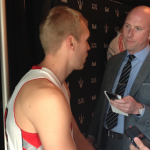 TEASER: Prize Fighters
TEASER: Prize Fighters Is La Presse+ the solution to newspaper woes or a capitulation to advertisers?
Is La Presse+ the solution to newspaper woes or a capitulation to advertisers? 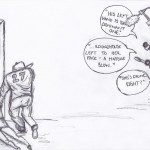 Missed opportunity: the Rice video was about domestic abuse, not sports
Missed opportunity: the Rice video was about domestic abuse, not sports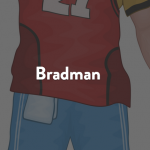 Bradman’s narrative
Bradman’s narrative  A look back at the news coverage of the Ottawa shooting
A look back at the news coverage of the Ottawa shooting Jane Armstrong takes her passion for investigative journalism to The Tyee
Jane Armstrong takes her passion for investigative journalism to The Tyee
by Alanna Kelly
Alanna Kelly is the Spring 2015 senior online editor. She will talk and play any sport you throw her way. She also has an interest in multi-platform and photo journalism.



